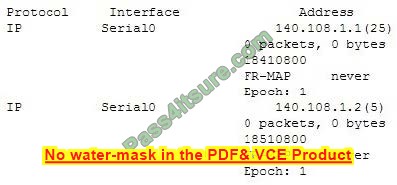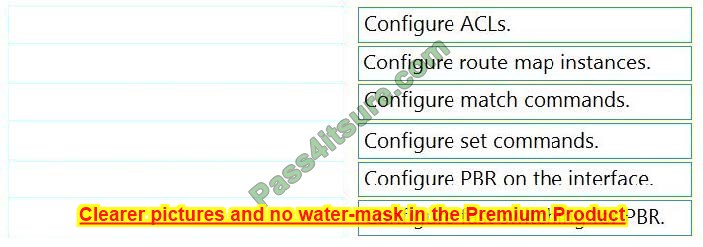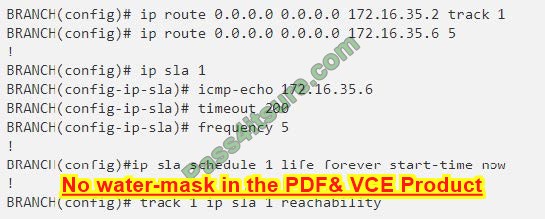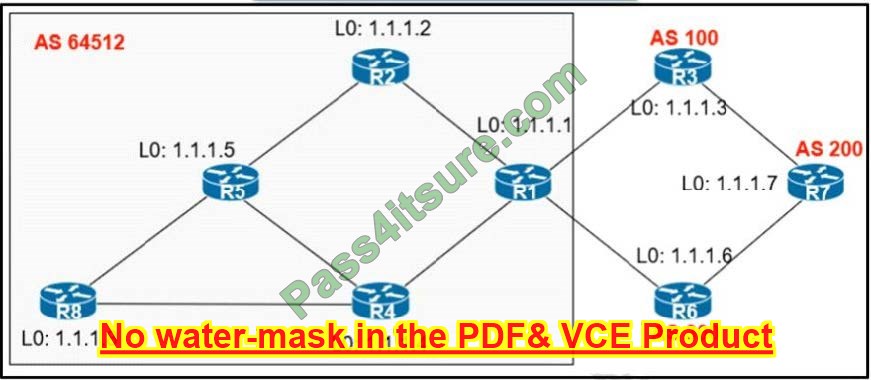Pass4itsure 300-410 dumps Complete the latest real-world scenario tests to meet candidate exam requirements! Use the 300-410 ENARSI exam practice materials anytime 100% guaranteed!
The current 300-410 ENARSI exam practice material contains 808 new exam questions and answers! Now, download 300-410 dumps: https://www.pass4itsure.com/300-410.html, and get complete test practice materials to help you pass the test easily!
Cisco 300-410 ENARSI Exam Details
This exam tests your knowledge of implementation and troubleshooting for advanced routing technologies and services, including:
- Layer 3
- VPN services
- Infrastructure security
- Infrastructure services
- Infrastructure automation
| Exam name: | Implementing Cisco Enterprise Advanced Routing and Services (ENARSI) |
| Exam code: | 300-410 |
| Duration: | 90 Min |
| Languages: | English and Japanese |
| Number of exam questions: | 55-65 |
| Type: | Multiple choice (single and multiple answers) Drag-and-drop Fill-in-the-blank Simulation Simlet Testlet * Single-choice and multiple-choice questions are the main question types |
| Price: | 300$ |
| Take the 300-410 exam: | In-person, Online (Pearson Vue) |
| More: | 300-410 Exam |
Online Practice New 300-410 ENARSI Exam Practice Materials From 300-410 Dumps
| From | Number of exam questions | Price | Associated certifications |
| Pass4itsure | 15/808 | Free | CCNP Enterprise |
Question 1:
Refer to the exhibit.

R3 cannot authenticate via TACACS. Which configuration resolves the issue?

A. Option A
B. Option B
C. Option C
D. Option D
Correct Answer: B
Question 2:
A network administrator is reloading a router and during the bootup, he is getting the error message “%Error opening tftp://255.255.255.255/network-confg (Socket error)”. What command need to be applied on Cisco Router to fix this issue.
A. No service config
B. Write erase reload
C. Reload noconfirm
D. Copy run start
Correct Answer: A
Question 3:
Which of the following commands enables Unicast Reverse Path forwarding in loose mode?
A. ip verify unicast source reachable-via rx
B. ip verify unicast source reachable-via any
C. ip verify unicast source reachable-via rx allow default
D. ip verify unicast source reachable-via allow default
Correct Answer: B
The command ip verify unicast source reachable-via any enables Unicast Reverse Path Forwarding (RPF) in loose mode. In loose mode, traffic is allowed if the source address is reachable via any interface on the router as indicted in the routing table.
Unicast Reverse Path forwarding uses the source IP address when it validates the packet. Packets are validated when the source address is contained in the routing table and is reachable either via the ingress interface (strict mode) or via any interface (loose mode).
The command ip verify unicast source reachable-via rx enables Unicast RPF in strict mode, not loose mode. The rx keyword indicates the source must be reachable on the interface where the packet arrived.
The command ip verify unicast source reachable-via rx allow default enables Unicast RPF in strict mode. The inclusion of the allow default keyword indicates the source can be reachable via a default route to be accepted.
The command ip verify unicast source reachable-via allow default is syntactically incorrect. The allow default keyword cannot be present by itself. It must follow either the rx or any keywords.
Objective:
Infrastructure Security
Sub-Objective:
Configure and verify router security features
References:
Understanding Unicast Reverse Path Forwarding
Cisco > Cisco IOS Security Command Commands D to L > ip verify unicast source reachable-via
Question 4:
Refer to the exhibit.

The server for the finance department is not reachable consistently on the 200.30.40.0/24 network and after every second month it gets a new IP address. Which two actions must be taken to resolve this Issue? (Choose two.)
A. Configure the server to use DHCP on the network with default gateway 200 30.40.100.
B. Configure the server with a static IP address and default gateway.
C. Configure the router to exclude a server IP address.
D. Configure the server to use DHCP on the network with default gateway 200 30.30.100.
E. Configure the router to exclude a server IP address and default gateway.
Correct Answer: BC
Question 5:
Refer to the exhibit.The control plane is heavily impacted after the CoPP configuration is applied to the router. Which command removal lessens the impact on the control plane?

A. access-list 120 permit eigrp any host 224.0.0.10
B. access-list 120 permit ospf any
C. access-list 120 permit udp any any eq pim-auto-rp
D. access-list 120 permit tcp any gt 1024 eq bgp log
Correct Answer: C
Question 6:
The following commands were executed on the perimeter router. The Fa1/0 interface in the router is the external interface.

What will be the effect of these commands?
A. all traffic will be blocked incoming
B. traffic sourced from private IP addresses will be blocked incoming
C. traffic destined for private IP addresses will be allowed incoming
D. no traffic will be blocked incoming
Correct Answer: A
All traffic will be blocked incoming. While it appears on the surface that this list was designed to block incoming traffic sourced from private IP addresses, it is lacking a single permit statement. Due to the implied deny all at the end of the list, no traffic will be allowed incoming.
Blocking incoming traffic from private IP addresses is a way to prevent IP spoofing, since there should be no reason for traffic from private IP addresses to be incoming from the Internet. However, you need to include a permit statement at the end to allow all other traffic types.
Traffic destined for private IP addresses is not all that will be blocked by this command set. In fact, no traffic would be allowed.
If there were a permit ip any any at the end of the list, then incoming traffic destined for private IP addresses would be allowed. This is probably not a great idea either, but if it a permit IP any were added at the end of the command set in the scenario, it would allow incoming traffic destined for private IP addresses.
Objective:
Infrastructure Security
Sub-Objective:
Configure and verify router security features
References:
Cisco > Cisco IOS Security Command Commands A to C > access-list Cisco > Cisco IOS Security Command Commands D to L > ip-group Prevent IP spoofing with the Cisco IOS
Question 7:
Examine the following output.

What possible reason(s) can cause the state of the first entry in the adjacency table? (Choose all that apply.)
A. the interface is a multipoint interface
B. the clear ip arp command was executed
C. the Layer 3 information is unknown
D. the clear adjacency command was executed
Correct Answer: BD
If either the clear ip arp or the clear adjacency commands were issued, the entry would temporarily be listed as incomplete in the adjacency table.
The adjacency table is used by Cisco Express Forwarding (CEF) to maintain Layer 2 information about the next hop to remote networks. In CEF, an adjacency refers to a control structure that holds Layer 2 information for an IP address on a particular interface.
When that information is not available the entry will be listed as incomplete, as shown in the example.
Layer 2 information normally comes from the ARP process. Therefore, if the ARP table is cleared with the clear ip arp command, the Layer 2 information will be temporarily unavailable until the ARP process re-learns it the next time a frame must be sent to that hop.
Moreover, if the adjacency table is emptied with the clear adjacency command, the entry must be created again.
This will also result in the entry being marked incomplete for a short period of time until the ARP table can be consulted and the Layer 2 information re- added.
The interface in the scenario is not a multipoint interface. A multipoint interface would include entries for multiple next hops, since a multipoint interface connects to multiple Layer 3 destinations. An example of this is shown below in sample output from a Frame Relay interface:

The layer 3 information of the next hop is present in the entry in the scenario example. It is 10.10.10.2.
Objective:
Network Principles
Sub-Objective:
Identify Cisco Express Forwarding concepts
References:
Home > Support > Technology support > IP > IP switching > Troubleshoot and alerts > Troubleshooting Technotes > Troubleshooting Incomplete Adjacencies with CEF
Question 8:
DRAG DROP
Drag and drop the actions from the left into the correct order on the right to configure a policy to avoid following packet forwarding based on the normal routing path.
Select and Place:

Correct Answer:

Step 1 – configure ACLs Step 2 – configure route map instances Step 3 – configure match commands Step 4 – configure set commands Step 5 – configure PBR on the interface Step 6 – configure fast switching for PBR
Reference: https://community.cisco.com/t5/networking-documents/how-to-configure-pbr/ta-p/3122774
Question 9:
Refer to the exhibit.

Traffic from the branch network should route through HQ_R1 unless the path is unavailable. An engineer tests this functionality by shutting down interface on the BRANCH router toward HQ_R1 router but 192.168.20.0/24 is no longer reachable from the branch router. Which set of configurations resolves the issue?

A. HQ_R1(config)# ip sla responder HQ_R1(config)# ip sla responder icmp-echo 172.16.35.2
B. BRANCH(config)# ip sla 1 BRANCH(config-ip-sla)# icmp-echo 172.16.35.1
C. HQ_R2(config)# ip sla responder HQ_R2(config)# ip sla responder icmp-echo 172.16.35.5
D. BRANCH(config)# ip sla 1 BRANCH(config-ip-sla)#icmp-echo 172.16.35.2
Correct Answer: D
In the configuration above, the engineer has made a mistake as he was tracking 172.16.35.6 (the backup path) instead of tracking the main path (172.16.35.2). Therefore,when he shut down the main path, the track 1 was still up so traffic still went through the main path -> it failed. To fix this issue, we just need to correct the tracking interface of the main path.
Question 10:
Which protocol is used in a DMVPN network to map physical IP addresses to logical IP addresses?
A. BGP
B. LLDP
C. EIGRP
D. NHRP
Correct Answer: D
Question 11:
Which BGP attribute can be used to influence the path that outgoing traffic takes from your AS to other Autonomous Systems? (Choose two.)
A. MED
B. AS_Path
C. Weight
D. Local Preference
Correct Answer: BD
Question 12:
The following access lists are applied to an interface connecting two OSPF routers:

What is the result?
A. the DR on the link will begin updating
B. the OSPF adjacency will go down
C. the last deny statement will fail to log traffic
D. the list will only permit IPv6 neighbor advertisements
Correct Answer: B
If this list is applied to the interface connecting two OSPF routers, the OSPF adjacency would go down. The deny ip any any log statement will deny the IPv6 link local addresses, which are used for the neighbor discovery process and by OSPF routers to establish neighbor adjacencies when directly connected.
By default, IPv6 access lists have a deny all at the end that does NOT include those addresses. However, when you set an explicit deny all as shown in the scenario, you will block all traffic that is not specified by an earlier statement in the list.
The DR on the link, if present, will not begin updating because the adjacency will fail. It will then have no neighbor to update.
The last deny statement in the scenario will log any traffic it blocks, as indicated by the inclusion of the log keyword.
The list will NOT permit neighbor advertisements. These are always done in terms of link local addresses, which the explicit deny ip any any log statement at the end will block.
Objective:
Infrastructure Security Sub-Objective: Configure and verify router security features References: Security Configuration Guide: Access Control Lists, Cisco IOS XE Release 3S > IPv6 Access Control Lists Cisco > Cisco IOS IPv6 Command Reference > ipv6 access-list Cisco > Cisco IOS Security Command Commands M to R > permit
(IP) Cisco > Cisco IOS Security Command Commands D to L > deny (IP)
Question 13:
Refer to the exhibit. Which command must be configured to make VRF CCNP work?

A. interface Loopback0 vrf forwarding CCNP
B. interface Loopback0 ip address 10.1.1.1 255.255.255.0
C. interface Loopback0 ip address 10.1.1.1 255.255.255.0 vrf forwarding CCNP
D. interface Loopback0 ip address 10.1.1.1 255.255.255.0 ip vrf forwarding CCNP
Correct Answer: B
Question 14:
Which feature of the Cisco DNA Center allows you to run diagnostic CLI commands to the devices that are managed by DNA Center for troubleshooting purposes?
A. Command Runner
B. DNA Spaces
C. DNA Advantage
D. Intelligent Capture
Correct Answer: A
Question 15:
Refer to the exhibit. An engineer configured R2 and R5 as route reflectors and noticed that not all routes are sent to R1 to advertise to the eBGP peers. Which iBGP routers must be configured as route reflectors to advertise all routes to restore reachability across all networks?

A. R1 and R4
B. R1 and R5
C. R4 and R5
D. R2 and R5
Correct Answer: C
When R2 and R5 are route reflectors (RRs), routes from R4 and R8 are advertised to R5 and R5 advertises to R2. But R2 would drop them as R2 is also a RR. Thereforesome routes are missing on R1 to advertise to eBGP peers.
Good reference: https://www.ciscolive.com/c/dam/r/ciscolive/emea/docs/2015/pdf/TECRST-2310.pdf
Route reflectors (RR) must be fully iBGP meshed so we cannot configure RR on both R1 and R5.
We should choose routers at the center of the topology RRs, in this case R4 and R5
…
Pass4itsure 300-410 ENARSI exam practice material comes in both PDF and VCE study formats! Contains 808 new exam questions and answers! After the actual scene test, it is real and effective!
Download Pass4itsure 300-410 dumps at any time to get timely and effective exam practice materials, guaranteeing that you will pass the exam 100% and give you 365 days of free updates!